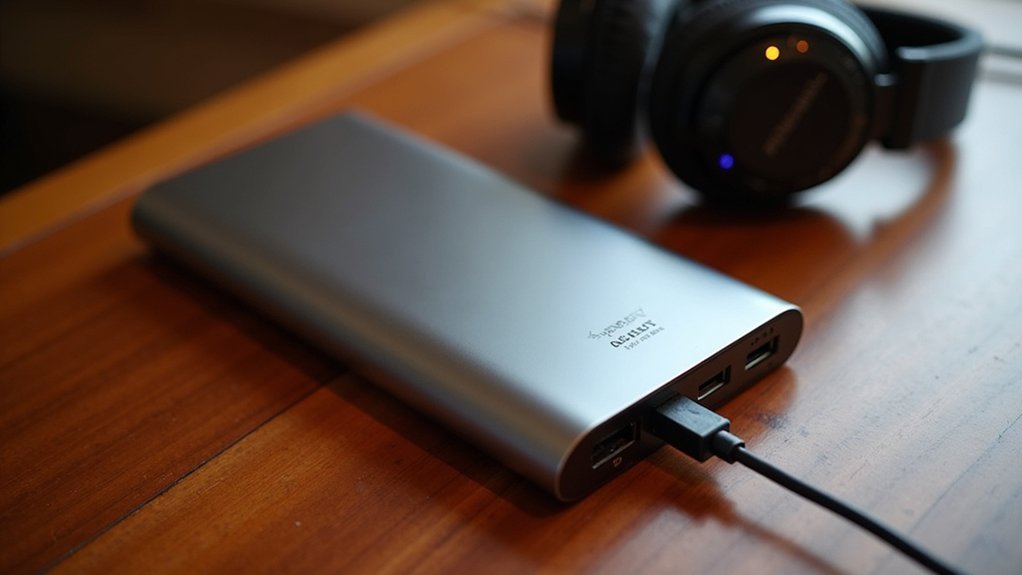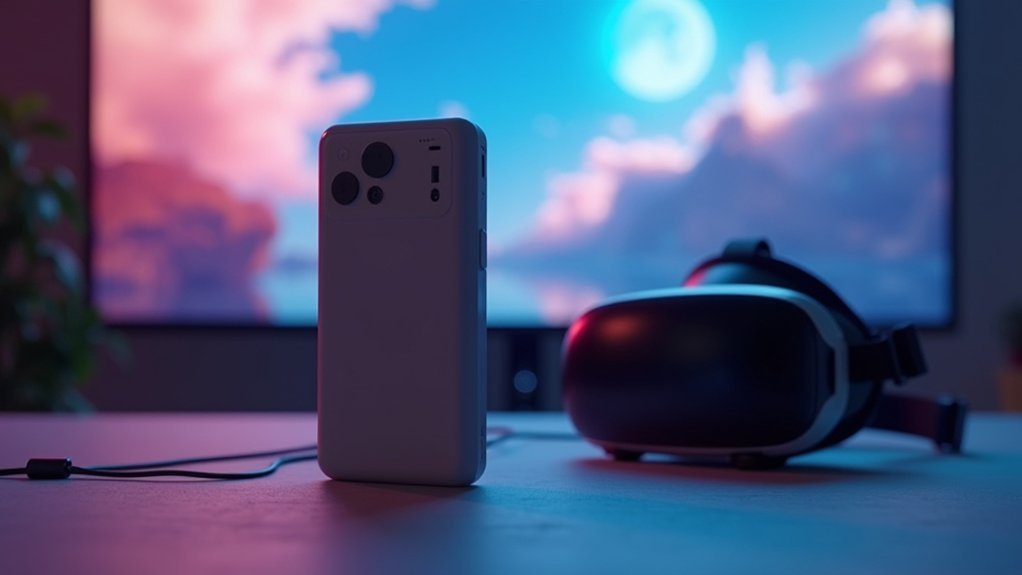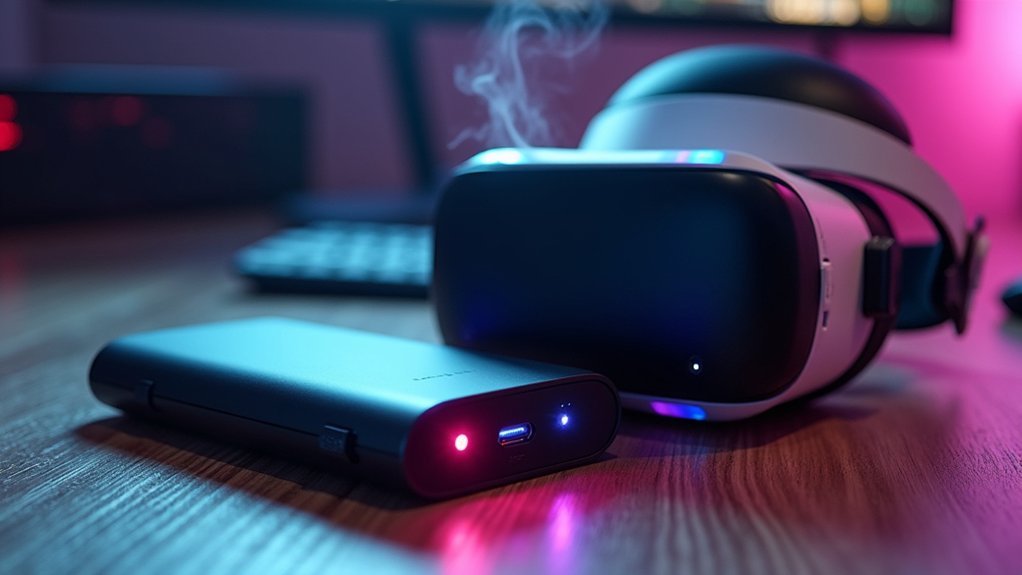You’ll need a power bank delivering at least 10W (5V 2A) output to keep your Quest headset running without battery drain. High-capacity models like 10,000mAh provide 4-6 hours of gameplay, while 20,000mAh options extend marathon sessions. Choose lightweight options around 2.46 ounces from reliable brands like Anker or RAVPower. Look for USB-C compatibility, built-in temperature control, and safety certifications to prevent overheating during intensive gaming. The right specifications make all the difference for uninterrupted VR experiences.
Essential Power Bank Specifications for Quest Headsets

When selecting a power bank for your Quest headset, you’ll need to prioritize specific technical requirements to guarantee seamless performance. Your power bank must deliver at least 5V 2A (10W) output to assure compatibility and effective charging during use.
Many users find that power banks with 2.4A output can maintain their headset’s battery near 100% throughout extended gaming sessions.
The USB-C port quality matters greatly – you’ll want to invest in high-quality cables since they directly impact charging efficiency and speed.
While some third-party power banks work well with Quest headsets, their performance isn’t officially confirmed.
High-Capacity Power Banks That Prevent Battery Drain
You’ll find that 10,000mAh power banks offer a solid balance between capacity and portability for extended Quest sessions.
These models can typically maintain your headset’s battery level for 4-6 hours of continuous play without significant drain.
If you’re planning marathon gaming sessions or multi-day events, 20,000mAh options provide even longer runtime, though they’ll add more weight to your setup.
10,000mAh Models
High-capacity power banks with 10,000mAh or greater ratings deliver the sustained power needed to keep your Quest headset running at full capacity during marathon gaming sessions.
These battery packs provide enough juice to maintain your headset near 100% charge throughout extended play periods.
When selecting an external battery, you’ll want models that output at least 5V 2A consistently.
Power Delivery (PD) support and dual output ports enhance performance considerably.
Twenty-thousand mAh models offer several hours of uninterrupted gameplay without draining your headset’s internal battery.
Reliable brands like Anker and RAVPower have proven track records with VR headsets.
Look for battery packs rated at 5V 2.4A or higher to meet your Quest’s power demands during intensive applications and guarantee seamless gaming experiences.
20,000mAh Options
Power banks exceeding 20,000mAh represent the ultimate solution for preventing Quest battery drain during extended VR sessions.
These high-capacity power banks deliver exceptional battery life extension, maintaining your headset near 100% charge throughout gameplay. You’ll need models with 5V 2A output or higher to guarantee ideal compatibility and performance.
With 2.4A output, these powerhouses can completely counteract your Quest’s power consumption, eliminating interruptions during marathon gaming sessions.
The extra capacity means you won’t worry about the power bank itself dying mid-session. Additionally, these high-capacity power banks help reduce overheating issues that typically occur when charging while playing, creating a more comfortable VR experience.
Third-party options work well, though performance varies by manufacturer.
Fast Charging Power Banks for Uninterrupted VR Sessions

While extended VR sessions can drain your Quest headset’s battery in just 2-3 hours, fast charging power banks guarantee you won’t miss a moment of immersive gameplay.
Fast charging power banks ensure uninterrupted VR adventures when your Quest battery dies after just 2-3 hours of gameplay.
You’ll need at least 5V 2A (10W) output for proper compatibility, though 2.4A power banks perform exceptionally well at maintaining 100% battery levels during extended play.
High-quality USB C cables supporting Power Delivery standards dramatically improve charging speeds and consistency.
For maximum power delivery, you can use a 65W laptop power brick that’ll keep your Quest 3 running while charging during intensive activities.
However, you should avoid charging while playing to prevent overheating issues.
Continuous use generates thermal buildup that can compromise your headset’s performance and longevity, making strategic charging breaks essential for ideal VR experiences.
USB-C Power Banks Optimized for Quest 3 and Quest 2
You’ll need USB-C power banks that deliver at least 5V 2A (10W) output to maintain your Quest 3 or Quest 2’s battery level during extended sessions.
Your power bank’s output capacity directly affects whether it can sustain charging while you’re actively gaming, with 2.4A models proving most effective for keeping battery levels near 100%.
Managing heat buildup becomes critical when using high-output USB-C power banks, as excessive temperatures can throttle charging performance and affect your headset’s operation.
Power Output Requirements
Understanding the electrical demands of your Quest headset is essential for selecting an effective power bank solution that won’t leave you tethered to a wall outlet.
Your Quest headset requires specific power output specifications to charge effectively during gameplay sessions. The minimum power output you’ll need is 5V and 2A through the USB port, delivering 10W of charging power.
However, many users achieve better results with power banks offering 2.4A output, which can maintain your headset’s battery at nearly 100% during extended use.
- Look for power banks with dedicated USB-C ports designed for modern devices
- Verify the power bank delivers consistent 2A or higher output current
- Choose models specifically tested with VR headsets for ideal compatibility
- Confirm your USB-C cable supports the required power output specifications
- Test different power bank brands to find your ideal charging performance
Heat Management Solutions
Heat buildup becomes a critical concern when charging your Quest headset during extended gaming sessions, as the combination of processing demands and simultaneous charging can push internal temperatures beyond comfortable limits.
External power banks offer effective heat management by reducing strain on your headset’s internal charging circuits. When you maintain consistent power delivery through a quality USB-C power bank, your headset doesn’t need to work as hard to keep the internal battery charged, resulting in lower operating temperatures.
You’ll notice considerably less thermal stress when using a 2.4A external power source instead of relying solely on wall charging during gameplay.
Monitor your headset’s temperature regularly and verify proper ventilation around charging ports. This proactive heat management approach prevents performance throttling and extends your hardware’s lifespan.
Power Banks That Avoid Overheating During Extended Play

When you’re pushing through marathon VR sessions, selecting a power bank that maintains ideal temperatures becomes critical for both performance and safety.
Power banks with lower output ratings can greatly reduce heat generation while still providing consistent power to your Quest headset. You’ll want to monitor your device’s temperature regularly, especially when playing demanding games that push your hardware to its limits.
- Choose power banks with 5V 2A (10W) minimum output for optimal balance between power and heat
- Consider 2.4A models that maintain battery levels near 100% without excessive heating
- Monitor device temperature during intensive gaming sessions to prevent overheating
- Select third-party options with proven cooling efficiency and reliable performance records
- Prioritize lower-powered external batteries for extended play sessions requiring temperature control
Portable Battery Solutions for Multi-Hour Gaming Sessions
Extended VR gaming sessions demand reliable portable power solutions that can sustain your Quest headset for hours without interruption.
Power banks with 2.4A output capacity effectively maintain your headset’s internal battery near 100% throughout marathon gaming sessions. Third-party options provide consistent power delivery, though performance varies between different models and headset interactions.
For uninterrupted gameplay, you’ll want power banks delivering at least 5V 2A (10W) output to match your headset’s power requirements.
However, avoid charging while actively gaming, as this creates overheating issues and insufficient power delivery. Instead, charge during breaks between sessions.
If you need continuous operation without battery depletion, consider using a 65W laptop power brick, which allows simultaneous charging and gaming without compromising your headset’s internal battery performance or causing thermal issues.
Power Bank Safety Features for VR Device Protection
Although power banks offer convenient portable charging for Quest headsets, they can pose serious risks to your expensive VR equipment without proper safety protections.
Power banks provide essential portable charging for Quest headsets but require proper safety protections to prevent costly damage to VR equipment.
You’ll need to verify that your chosen power bank includes safety-certified protections to prevent damage during extended gaming sessions.
Essential safety features you should look for include:
- Over-charge, over-current, over-voltage, and short-circuit protection certifications
- Minimum 5V/2A (10W) output rating for proper compatibility
- Built-in temperature control to prevent overheating during use
- Automatic shut-off feature to prevent over-discharge damage
- Stable power supply delivery to avoid gameplay interruptions
These safety mechanisms guarantee your power bank won’t harm your VR devices while providing reliable performance.
Prioritizing certified protection features safeguards both your headset’s internal components and extends your power bank’s lifespan.
Lightweight Power Banks That Enhance VR Mobility
Carrying around bulky power banks defeats the purpose of wireless VR gaming, which is why you’ll want to prioritize lightweight options that maintain your headset’s mobility advantage.
Look for compact power banks weighing around 2.46 ounces that deliver at least 5V 2A (10W) output. These lightweight power banks won’t burden your movements while providing sufficient juice for extended sessions.
Many users find 2.4A models particularly effective, as they keep the headset battery near 100% throughout prolonged gameplay.
Beyond maintaining power levels, properly rated lightweight units help prevent heat buildup during demanding VR experiences.
Pair your chosen power bank with high-quality USB-C cables to maximize charging efficiency and guarantee peak headset performance during those marathon gaming sessions.
Power Bank Performance Testing With Quest Headsets
Testing your power bank’s performance with your Meta Quest headset before extended gaming sessions will save you from mid-game disappointments and help you understand your setup’s limitations.
You’ll want to verify that your power bank maintains at least 5V 2A output while monitoring how well it sustains your headset’s battery level during actual gameplay.
Start your testing with less demanding applications before moving to graphics-intensive games. A quality 2.4A power bank should keep your Meta Quest near 100% charge during moderate use, but performance varies between different brands and models.
- Monitor battery percentage changes during 30-minute gaming intervals
- Test with both lightweight and demanding VR applications
- Check cable connection stability throughout extended sessions
- Document any overheating issues during charging
- Compare performance across different power bank brands
Frequently Asked Questions
Can I Charge My Headset With Power Bank?
Yes, you can charge your Quest headset with a power bank. You’ll need one that outputs at least 5V 2A and use a high-quality USB-C cable for effective charging performance.
Can You Use a Power Bank With Oculus Quest 2?
Yes, you can use a power bank with your Oculus Quest 2. You’ll need one that outputs at least 5V 2A for compatibility. High-capacity banks work best for extended sessions.
Can I Use a Power Bank With Quest 3?
You can use a power bank with your Quest 3. You’ll need one with at least 5V 2A output for compatibility. Many users report success with 2.4A-rated power banks maintaining battery levels.
What Is the Battery Life of the Quest Headset?
You’ll get about 2-3 hours of battery life from your Quest headset during active use. The actual runtime depends on how demanding your VR applications are and which features you’re using.





Leave a Reply